Fescue Grasses
By Garrett Schultz
Introduction: Fescue Grasses are cool season grasses, and are grown mainly in the transition zone of the United States and into Canada. Fescues are known for not only their drought tolerance, but also their shade tolerance, which makes Fescue a desirable species of grass because of its suitability to different conditions. Fescue grasses possess the ability to stay green all year long as well, which only adds to their desirabilty as a turfgrass species. Most cool season grass species do not perform well in the lower area of the transition zone where the seasons are too hot for them to survive, and most warm season grasses cannot thrive in the upper part of the transition zone where the seasons are too cool for the grasses to grow and prosper. Fescues grasses are able to effectively fill in this gap in growing conditions, and have been known to thrive where many other species will not grow.
Transition Zones of the U.S.
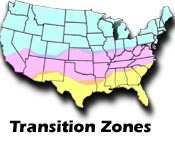
The following are descriptions and attributes of several different species of Fescue Grasses.
Tall Fescue
Tall Fescue is a bunch type grass that is established from seed. It is coarse bladed and dense, and grows well is shady areas. It also has a dense root system, which makes it very resilient to drought conditions. This, along with it's tolerance of shade, makes Tall Fescue a desirable grass in seed mixtures for home lawns. It also stays green year long, giving a typical lawn a sense of aesthetic beauty. Tall Fescue is able to endure heavy foot traffic and other forms of wear and compaction.
Varieties: *Kentucky 31- One of the more popular varieties, Kentucky 31 is adapted to grow well in the upper area of the Transition Zone where the warm season grasses won't grow, as well as the lower area of the Transition Zone where the cool season grasses won't grow.
Where It's Used: Lawns, athletic fields, parks, and anywhere a dense turf is desired.
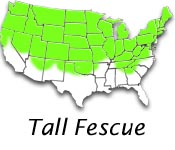 |
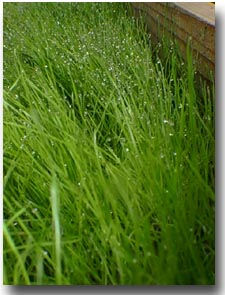 |
Creeping Red Fescue
Creeping Red Fescue is a cool season grass used in the cooler temperate regions of the North. It is a fine fescue and has narrow, deep green blades. It tends to prefer shady, cooler areas. It is often used in mixtures with Tall Fescue, as well as Bluegrass and Perennial Ryegrass. Creeping Red Fescue is known for its ability to establish a lawn quickly, as well as the ease of which it is maintained due to its non-aggressive nature. It is one of the most widely used grasses used to overseed lawns of cool season species of grass.
Varieties: *Cindy Lou- This variety of Creeping Red Fescue has the best ability to "creep" or spread through underground shoots, which allows it to fill in bare spots and repair damaged turf. It thrives in shady locations and sandy soils, but is widely used in lawns as well as golf greens.
Where It's Used: Lawns, erosion sites, steep slopes, along roadsides, meadows, and golf greens.
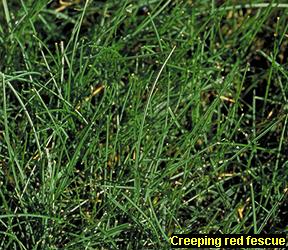
Chewings Fescue
Chewings Fescue closely resembles Tall Fescue in that it grows very upright rather than creeping. It does, however, have the fine texture that is characeteristic of the fine fescue species. Chewings Fescue is a bunch type grass and grows well in the shade, in addition to being drought resistant. A downside of this type of fescue is that it does not tolerate wear and traffic as well as some of the other species. A positive characteristic is that Chewings Fescue prospers in sandy soils of low fertility, and has the ability to be mown shorter than other fescues. Its most popular use is in mixtures.
Varieties: *Windward Chewings Fescue is the most popular variety, and is known to be tough, long lived, and for its ability to grow in acidic soils. It is endophyte enhanced, which means it has the natural ability to deter harmful insects.
Where It's Used: Shady lawns, areas of acidic or sandy soils; typically found in the Northern U.S. and Canada.
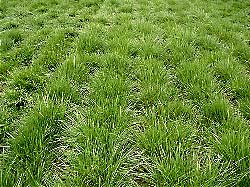
Hard Fescue
Hard Fescue is the "toughest" of all the fescues in that it is the most drought resistant, shade tolerant, and disease resistant than the other species. It is a clump type grass that can be grown in very adverse conditions as well as extremely shady areas, typically in the Northern regions and in higher elevations. Hard Fescue can be distinguished by its characteristic blueish green appearance, and its ability to stay green longer. It may not be cut as low as the other fescues, but is relatively slow growing and requires little maintenance. Hard Fescue is the only fescue grass that is salt tolerant.
Varieties: *Warwick Hard Fescue is one of the most popular and widely used varieties, and is known for its ability to survive in extreme drought conditions or in very shady conditions. Warwick Hard Fescue, which has a deep root sytem and is endophyte enhanced, is particularly well suited for soils of low maintenance and low fertility, where mowing is not feasable, and in areas where adverse weather prevents the growth of other turfgrass.
Where It's Grown: Areas of low maintenance, where mowing is not possible, sites of erosion, areas of reclamation planting, and in soils that are very salty.
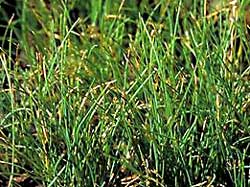
Information compiled from: www.fescue.com, www.tallfescue.com, www.wikipedia.com
Pictures compiled from: www.google.com/images
Questions? Comments? Concerns? Contact: Garrett Schultz